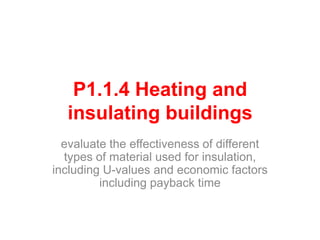
P1.14 heating and insulating buildings
- 1. P1.1.4 Heating and insulating buildings evaluate the effectiveness of different types of material used for insulation, including U-values and economic factors including payback time
- 2. KEY WORDS Energy Work Transfer U-values Payback time Specific heat capacity
- 3. One way to reduce the amount of heat that escapes from a house is to insulate it so that the heat energy escaping is reduced Where is the most heat lost? What can be done to reduce the heat loss?
- 4. Important ways of reducing heat loss in a home are: • Loft insulation – this is a thick layer of fibre glass laid across the loft space. It reduces conduction and convection.
- 5. Important ways of reducing heat loss in a home are: Cavity wall insulation – this is foam squirted between the gaps between bricks. It reduces conduction and convection.
- 6. Important ways of reducing heat loss in a home are: A jacket for the hot water tank this reduces conduction and radiation.
- 7. Air is an insulator/ poor conductor Convection stopped foam is an insulator/ poor conductor
- 8. Heat is conducted through the glass Heat passes through the glass and air by radiation Heat crosses the gap by convection Light X-rays Sound Radio
- 9. Cuts down convection currents Air pockets trap air (from moving) Foam is a poor conductor/ good insulator Evaporation of water takes energy from the house
- 11. 100 – (15+15+10+25) = 35% Cavity wall insulation and roof insulation
- 12. Payback time – the time taken to recoup the initial payment - for these is calculated by: Initial cost ÷ annual saving Example It costs £250 to install and fit loft insulation in a house. It saves £50 a year. How long is the payback time? Solution Using: Payback time = Initial cost ÷ annual saving Then £250 ÷ £50 = 5 years.
- 13. U-values a) U-values measure how effective a material is as an insulator. The U-value shows how fast heat can transfer through a material. The higher the U-value the faster the heat transfer. b) The lower the U-value, the better the material is as an insulator. Good insulators have a low U-value.
- 14. 1 – it has the highest U-value
- 15. 3 and 4 OR 1 and 2 U-values for the 20 mm windows are the same or higher than those for the 16 mm windows therefore the 20 mm windows are no more energy efficient than 16 mm windows
- 16. c) Solar panels may contain water that is heated by radiation from the Sun. This water may then be used to heat buildings or provide domestic hot water.
- 17. The specific heat capacity of a substance is the amount of energy required to change the temperature of one kilogram of the substance by one degree Celsius. E is energy transferred in joules, J m is mass in kilograms, kg is temperature change in degrees Celsius, °C c is specific heat capacity in J / kg °C It indicates how much energy a substance can store. E = m x c x
- 18. Example How much energy is required to heat 3 kg of water from 20 °C to 100 °C. The specific heat capacity of water is 4200 J/ kg°C. Solution Using E = m x c x Substituting m = 3 kg c = 4200 J/ kg°C T = 100-20 = 80 °C Gives E = 3 x 4200 x 80 = 1008000 J
- 19. Example How much energy is required to heat 2 kg of water from 10 °C to 110 °C. The specific heat capacity of water is 4200 J/ kg°C. Solution Using E = m x c x Substituting m = 2 kg c = 4200 J/ kg°C T = 110-10 = 100 °C Gives E = 2 x 4200 x 100 = 840000 J
- 20. Other ways of reducing energy loss include replacing filament bulbs with low energy light bulbs and LED lighting
- 22. Replacing old appliances with energy efficient ones Newer appliances have an energy label. More efficient appliances are rated A. Other ways of reducing energy loss include
- 23. An advertisement in a shop claims that: ‘Replacing an old freezer with a new ‘A’ rated freezer will benefit the environment.’ Do you agree that replacing the freezer will benefit the environment? YES Less electricity used / energy needed Less fossil fuels burned Less polluting gases emitted NO Old freezer must be disposed of Hazardous chemicals inside freezer eg CFCs Lot of Energy used in producing new freezer